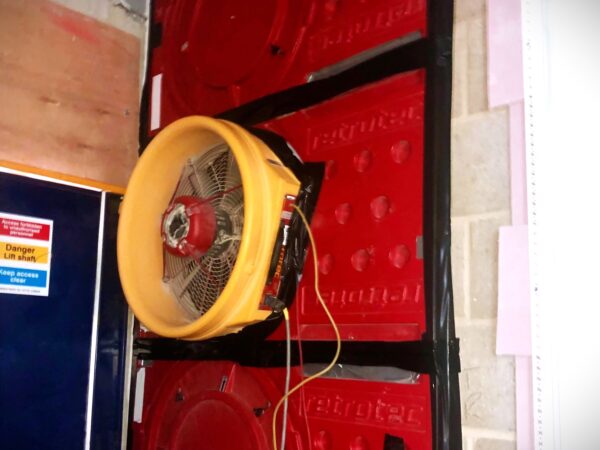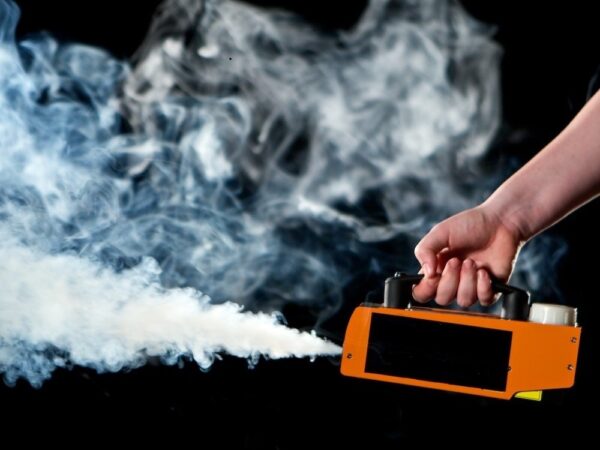Preparing your smoke shaft for the air test
When preparing and sealing a smoke shaft to pass an air test, there are several important factors to consider. Here is our roadmap to guide you to a successful smoke shaft air test:
- Know Your Airtightness Target – Smoke shafts for Automatic Opening Ventilation (AOV) typically need to achieve an airtightness level of less than 3.8 or 3.80 m³/h/m² @ 50 Pa. This requirement is quite stringent given the relatively small envelope area of smoke shafts against the volume.
- Seal all potential Leakage Paths: Smoke shafts are usually constructed using a combination of materials, including: Concrete casting: Concrete walls provide the tightest air barrier. Block work: High-density blocks are the next best option, as long as there are no gaps in mortar joints. Stud wall/plasterboard: Ensure full sealing between plasterboard panels and at junctions with concrete. Any penetrations in the shaft wall (such as openings for services, AOV fans, louvres, shutters, and floor grilles) must be properly sealed using a combination of tape/jointing, fire stopping, and mastic/foam. Ensure all the above areas are sealed from the inside of the smoke shaft.
- Timing of the Air Test: The air test should occur when the smoke shaft is fully complete and sealed but before the AOV fan and louvres/shutters have been installed. All the AOV doors should be shut for the test and the top of the shaft temporarily sealed.

The smoke shaft air test method
The air test should be undertaken by a UKAS/ATTMA company using the following pressurisation method, using a UKAS calibrated blower door fan to the CIBSE TM23 testing methodology:
- Ensure you have sized up the correct fan so its fits into one of the shaft openings, preferably half way up the shaft.
- Install the blower fan into an aperture created in a board temporarily sealing one of the louvre/shutter openings.
- The test duration is short (a few minutes), but the overall time on site may be around 3-4 hours.
- Test the smoke shaft to 3.8m3/hr/m2. The goal is to achieve the specified airtightness target.
What If the Smoke Shaft Fails to Achieve the Target?
Given the restricted access within the smoke shaft, the preferred method for finding air leakage is to:
- Pressurise the shaft using the fan and push theatrical smoke into the shaft using high powered smoke machines and Identify gaps or cracks where smoke escapes.
- Heat and pressurise the shaft and undertake a thermal imaging survey and Identify gaps or cracks where heat escapes.
- Use multiple operatives across different floors to act as spotters while the test engineer operates the fan.
- Record the findings of the survey in an air leakage report and show the areas to the client prior to leaving site.
If a smoke leakage test is required, inform as many people as possible (including the local fire brigade) and potentially limit access into the work areas during the test, and whilst the smoke disperses.

How we can help you pass your Smoke Shaft Air Test
Our experienced air test engineers have over 10 years in the field of smoke shaft testing, so we know how to help clients to pass their testing to achieve smoke shaft signoff.
Our premium smoke shaft testing service includes:
- Smoke shaft survey visits by experienced consultants.
- All testing undertaken by a UKAS and ATTMA Level 2 air testing company.
- UKAS Smoke shaft air test certification.
- The latest high-powered fan equipment
- UKAS calibrated equipment.
- Diagnostic leakage surveys testing using smoke machines & thermal imaging.
- Rapid testing service
We offer leading design, consultancy, and compliance for every part of your project. It’s APT’s aim to provide a friendly and professional stress-free experience from start to finish.
For more information on our air testing services for smoke shafts, please contact Darren direct on 07775623464, or email us at info@airpressuretesting.net
